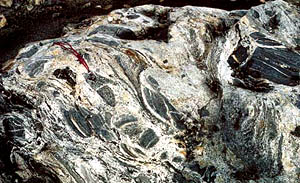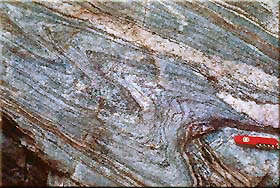Metamorphic rocks by definition are formed by a change in another rock. Metamorphism can only occur inside the earth and not at the earth's crust. The changes are caused by heat, and pressure on an already existing rock.
Metamorphic rocks must change without melting, they are solid state transformations. Why? Because if they melted and recrystallized they would be igneous!
Since the changes are done in the solid state, the textures and components in the rock often store historical information about the processes they have undergone. By cataloguing metamorphic rock types and determining the conditions under which they were formed, geologist are attempting to find ancient continental boundaries.
As we learned in the section on igneous rocks, melt temperature is directly relate to the amount of water (H2O) in the rock. If there is limited water in a rock, then initial melting will be limited to isolated areas in the rock. If a metamorphic rock is found with small areas of partial melting, then it is called a migmatite.
If more material melts, the loss in density and the migration of the melt can produce a basolith or other igneous intrusion. If the original material was metamorphic, then this combination is indicative of a subduction zone or a collision margin. When we find a large intrusive body with surrounding metamorphic rock we know the area was sometime in its history along a plate boundary.


Temperature
Pressure
Initial composition
Presence fluids
Time
| NEXT | TOC | PREV |